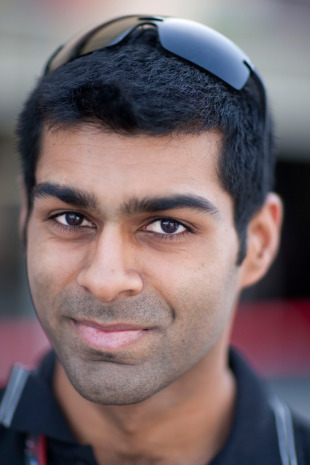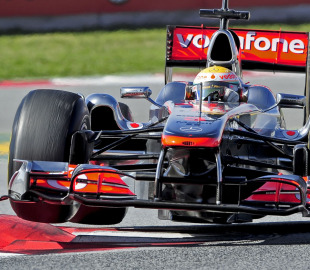
The pre-season testing for the 2011 season came to a close with the teams and drivers pounding around the south of Spain. Early signs are actually hard to read at the moment - certainly the Red Bull RB7 seems to have taken on where the championship winning car from last year left off, but it's still hard to read into just where everyone is relative to the opposition.
One thing for certain is that this is going to be a year where the tyre degradation issues are going to play a big part in the outcome of the races. The drivers seem to have a bigger drop off in performance than they have done recently on the Bridgestones, where at most circuits we used to have "negative tyre deg" - put simply, the effect of tyre wear would be less than the effect of a lap of fuel being burned. This is why you would often see drivers like Kimi Raikkonen and Seb Vettel chase the fastest lap on the last lap of the race when the fuel load was at its lowest.
In 2011, it seems we're likely to see two pit stops at every race as drivers will struggle to do more than 20 laps on a single set of tyres before it starts to become more beneficial to change on to a new set of tyres. Additionally, with the teams having the choices of tyre compounds, the early signs are that the super-soft tyres are exactly as the name suggests and it will be interesting to see how many drivers actually use them in Q3 of qualifying. Using the super soft in Q3 will mean that they will have to start the race on that tyre and this could be a real problem with wear, particularly during the early stages of the race with about 150kgs of fuel on board. I think we're going to see more people qualify on the harder tyre in Q3 than during the Bridgestone era and this could mix the grid up a bit more.
Overall though, I think it's wrong to criticise Pirelli as they have had to take on the really huge task of supplying tyres from no real baseline in recent F1, and in fact produce tyres that will make the racing better. At the end of the day, all 24 cars are on the same tyres so there's no real advantage or disadvantage.

The other two anomalies that will play a part in 2011 will be the KERS and the moveable rear wings. Apart from the three newest teams - Lotus, Virgin and HRT - every other team is running KERS from the first race at Australia this year after the FIA moved the weight limit up by 20kgs to encourage its use. It's an added complication for the drivers but could gain them a few tenths per lap if used properly. In 2009 we saw how the KERS cars of McLaren and Ferrari were able to make up places at the start of the race by using the added power, but this time around, with pretty much everyone at the front running KERS, I don't think it'll affect the racing as much. It's not a simple system for the drivers to use as the charging and discharging of the batteries needs to be monitored all the way around the lap so this could prove to be a real challenge alongside the rear wing.
The moveable rear wing looks like it's going to be a very powerful device. To put it simply, the driver pushes a button on the steering wheel and that opens a slot gap in the rear wing, creating less drag and allowing the car to go faster down the straight. At an average circuit like Barcelona, it could be worth 6 - 7 tenths per lap in qualifying if used properly but the FIA have imposed restrictions on the way it can be used during a race. Basically, the drivers will only be able to use the wing in a 600-metre zone at the end of a track's main straight if they have got within one second of the car ahead of them at a set point on the track. I think there will be a bit of trial and error here and the FIA are likely to make some tweaks as the season goes on.
At the moment, judging by what drivers are saying, the feeling seems to be it's not going to make a night-and-day difference to overtaking, but if there are instances where the driver is able to nearly pass the car in front, this may give him that crucial few car lengths he additionally needs to make the move stick. As long as there's still a challenge I think it will be a success, because if it was any easier it would be like wacky racers (or a scene out of a Hollywood movie) where a driver can just push a button and fly past another car, and that's not Formula One. Charlie Whiting and his team are very thorough and I'm sure they'll find a solution that's good for everyone.
I always enjoy pre-season testing - it's a great chance to see all the new ideas and provides a sense of anticipation with some big question marks about where everyone really is. As I said before, Red Bull Racing's new RB7 looks set to once again be the class of the field and Ferrari is widely expected to be next best, but behind them the battle is well and truly on.

Toro Rosso and Sauber have both looked very competitive in testing thus far, but we need to reserve judgement a little bit until we see everyone in low-fuel trim on track at the same time. The new Williams has an extraordinarily small gearbox which should be a big aerodynamic benefit and it will be nice to see them do well again. Renault's revolutionary new exhaust system seems to be working well and these four teams all look like they're going to be battling hard in the midfield, which will be as close as ever. Lotus has made a good step forward with its car compared to 2010 and, on a good day where the tyres and conditions suit it a bit more than the others, they could certainly start to mix into the midfield.
It's going to be a fascinating season ahead once again!
Karun Chandhok gives his views exclusively to ESPNF1 at the end of every grand prix weekend

